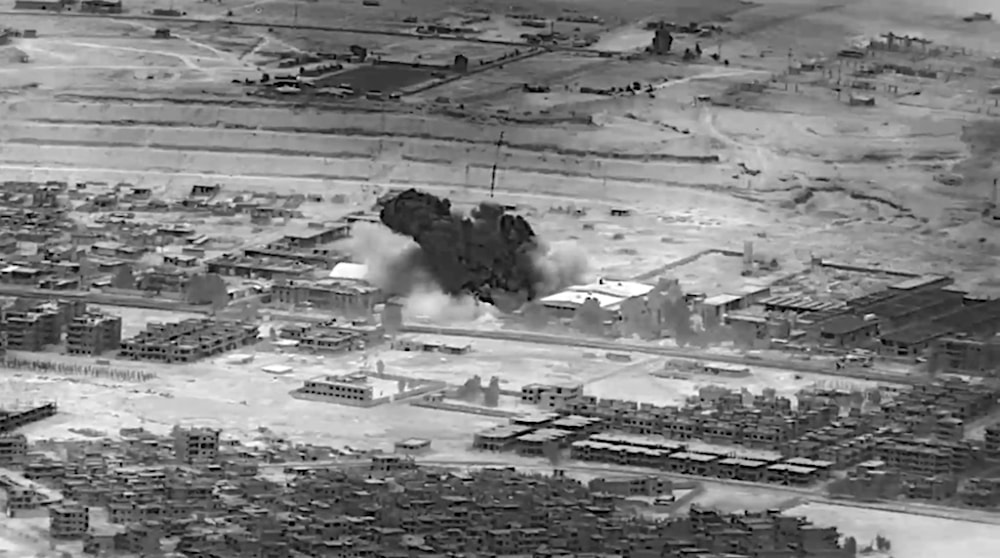US miscalculation in response to operations can lead to wider war: NYT
The United States making a miscalculation may lead to a large-scale war, the New York Times says as the White House considers its options.
-

This image from a video provided by the US Department of Defense shows a Nov. 8, 2023, airstrike on an alleged weapons warehouse in eastern Syria (Pentagon via AP)
The situation in the Middle East is prompting concerns within the United States, namely among national security officials, who are voicing growing concerns over the potential for a regional conflict following recent tit-for-tat attacks between the Israeli occupation forces and the Islamic Resistance in Iraq and Syria, The New York Times reported on Wednesday.
According to the NYT, officials fear a miscalculation, coupled with the belief on each side that the other does not desire a larger conflict could inadvertently trigger a broader war.
Citing unnamed US officials, the newspaper revealed that the Biden administration was urging the Israeli occupation to "lean away" from "skirmishes", in reference to the escalation in the north with the Islamic Resistance in Lebanon and the heroic Yemeni attacks on "Israel" in solidarity with the people of Gaza.
However, details on the specific measures being taken by the administration to prevent the Israeli occupation from opening a two-front war remain undisclosed.
Since the start of Operation al-Aqsa Flood on October 7, intelligence officials have been briefing US President Joe Biden on the risk of a wider war with Iran.
The assessment from intelligence agencies suggests that, at least for now, Iran aims to avoid a broader conflict.
US defense officials, guided by intelligence that Tehran does not want a war, have proposed targeted retaliatory measures against the Islamic Resistance groups attacking US occupation bases in Iraq and Syria.
As the White House considers its options, The New York Times notes that Avril Haines, the director of national intelligence, and Biden have engaged in discussions about potential outcomes.
Biden administration officials emphasize that the calibrated strikes are designed to impose costs on Iran and its so-called "proxies" - the Western nom de guerre for the majority of Resistance movements in the region, at least the ones Iran voices its support for - without sparking a regional war that could involve the United States.
The report, moreover, indicates that Biden rejected more aggressive bombing options in recent weeks, according to senior military officials.
The crucial question, as outlined by officials, revolves around whether President Biden can effectively prevent the Israeli occupation from expanding the circle of fire in the region.
Senior US military officials, cited in The New York Times, acknowledge that the United States has, so far, avoided more serious casualties largely due to luck amid the escalation in attacks by the Resistance on its occupation bases in Iraq and Syria.
Does US really seek peace?
The United States conducted airstrikes against two facilities used by Iran's Islamic Revolution Guard Corps (IRGC) and its allies in eastern Syria earlier in November, Pentagon officials stated after the latest target on US occupation bases in Iraq and Syria.
The NYT reported at the time that Air Force F-15E fighter jets struck several buildings in Abu Kamal and a safe house in al-Mayadeen four days after US warplanes hit a warehouse in eastern Syria.
On that note, US President Joe Biden rejected the Pentagon's proposal to continue their bombings, in fear of provoking "a wider conflict with Iran."
According to the NYT, the "White House's countermeasures have been so limited that Republican critics in Congress and some air power supporters argue that they just invite more frequent and lethal strikes on US soldiers in the region"."
Moreover, the Pentagon and other Biden administration officials dismissed criticisms, claiming that the American airstrikes were allegedly in self-defense, "proportionate to the attacks by Iran-backed militias, and meant to disrupt the militants' activities".
This comes after Iranian Defense Minister Mohammad Reza Ashtiani warned on November 5 that Iran would launch a "serious strike" on the United States in the event that the Israeli aggression on the Gaza Strip does not cease.
According to Tasnim, the brigadier general stated that Iran's advice to the US is to end the war "immediately," and "ensure a ceasefire." Ashtiani warned that if this is not implemented, the US will "face a serious strike."
US military to the Middle East
Since the launch of Operation al-Aqsa Flood, the US has been transferring military assets to the Middle East under the pretext of making efforts to "avoid a regional war that could pit US forces against Iranian proxies in Lebanon, Yemen, Iraq, and Syria".
Earlier this month, two US aircraft carrier strike groups, recently deployed to the Eastern Mediterranean, carried out a joint exercise simulating the possibility of being targeted by ballistic missiles and other aerial projectiles.
A total of 11,000 US military personnel participated in the drill, while the Italian warships Fasan and Margottini, also recently dispatched by Italy to the region following the start of the battle, joined the two carrier strike groups to exercise NATO alliance integration.
“The ships and aircraft of two US Navy aircraft carrier strike groups conducted joint exercises over the last three days,” the US Sixth Fleet said on Friday.
“Sailors and naval aviators from the USS Gerald R. Ford (CVN 78) Carrier Strike Group (CSG 12) and those of the USS Dwight D. Eisenhower (CVN 69) Carrier Strike Group (CSG 2) trained on high-value unit defense, ballistic missile defense, replenishments-at-sea, cross-deck flight operations, and maritime security operations."
Last month, a US Marine rapid response force headed to the eastern Mediterranean Sea due to concerns about the war in Gaza potentially expanding into a regional war, CNN reported, citing two officials.

 5 Min Read
5 Min Read








